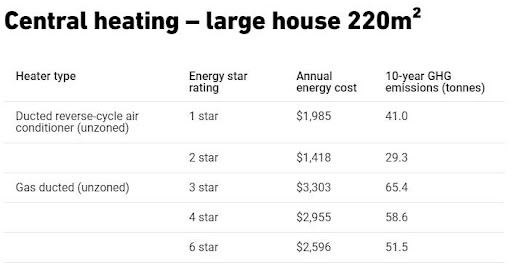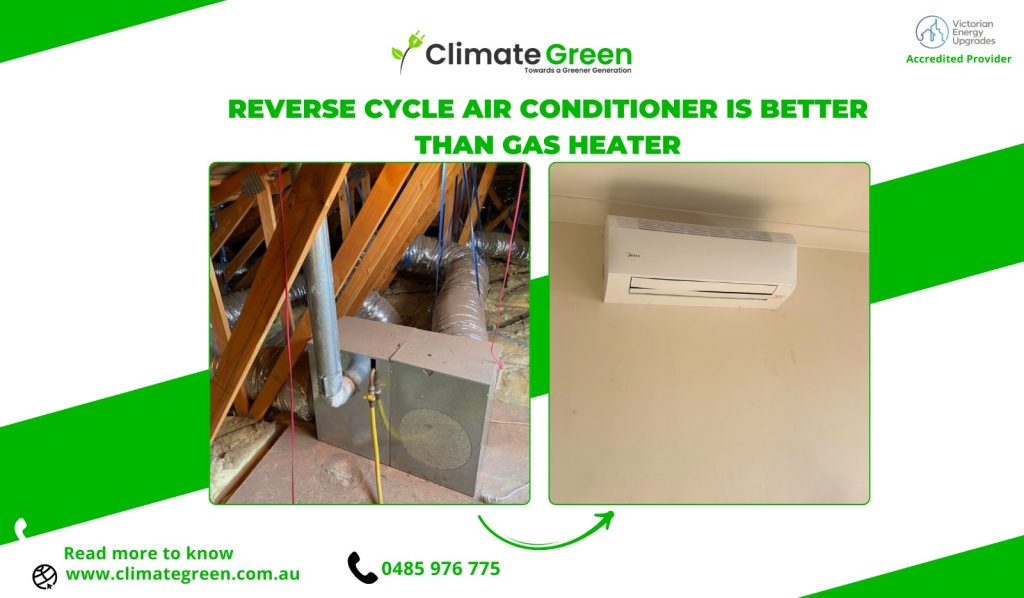Reverse Cycle Heating vs Gas Ducted Heating Climate Green Melbourne
You have two primary options to think about if you want ducted heating in your Melbourne home:
The conventional method of central heating is gas ducted heating. Gas ducted systems heat the air in your house by creating a flame in a gas furnace and distributing it throughout the house. It’s ducted systems that we’re mostly discussing here, not unflued gas heaters or any other type of gas space heater.
Reverse cycle air conditioning, or reverse cycle heating, is the more contemporary choice. Heat pump technology is used by reverse cycle systems to bring heat from the outside indoors. In order to function as air conditioners, these devices can also reverse the process.
The ideal choice for you will ultimately depend on your preferences, but when you consider the broader picture, reverse cycle heating is the “best” option.
However, you shouldn’t rule out ducted gas heating altogether.
This post will discuss the reasons behind our ranking of reverse cycle systems as the best, as well as a fair analysis of the advantages, parallels, and discrepancies of system.
Is Reverse Cycle Heating Cheaper Than Gas Ducted Heating?
The ideal choice for you will ultimately depend on your preferences, but when you consider the broader picture, reverse cycle heating is the “best” option.
However, you shouldn’t rule out ducted gas heating altogether.
This post will discuss the reasons behind our ranking of reverse cycle systems as the best, as well as a fair analysis of the advantages, parallels, and discrepancies of each system.
Which form of house heating is most affordable? It’s not simple.
You need to consider a number of factors, like the size of your home, zoning capabilities, the size of your heater, and the cost of your gas and electricity, to determine the real answer.
Gas is still somewhat less expensive overall for families, according to the comparison website Finder, even though it takes 3.6MJ of gas use to produce the same amount of electricity as 1KWh.
On the other hand, gas heaters can lose up to 50% of their energy when they are heating. This indicates that only roughly half of the energy needed to heat the house is utilized by the system; the remaining energy escapes through ducts, exhausts, and other channels.
Reverse cycle systems, on the other hand, have an efficiency of 300–600%, which means that one unit of electrical energy might produce six times as much heat.
This implies that, in a 220 m2 home, a 1-star reverse cycle system might offer central heating at a lower cost than a 6-star gas ducted system, according to Sustainability Victoria.

Therefore, even though a traditional portable electric heater is the most costly heating choice, more recent electric heating options, such as reverse cycle and heat pump systems, can operate significantly more affordably than gas.
Reverse cycle air heating might be the most affordable choice after all. This is particularly true if you have made an investment in solar energy (although the initial price of solar panels can be high).
Contact Us Now
Give Us a Call for Air Conditioning
Supply and Installation Charges: Ducted Reverse Cycle vs. Ducted Gas
Whether you choose a heat pump or gas ducted system, the cost of installation and supply will vary depending on your needs. This covers the system’s size, the quantity of outlets needed, and any further problematic elements.
Gas ducted heaters will typically cost between $3,000 and $7,000 or more, making them less expensive to purchase and install.
The typical supply and installation prices of reverse cycle ducted heaters range from $6,000 to $12,000 or more.
A smaller percentage of properties are connected to gas, but the majority are to electricity. The cost of gas ducted heating in Melbourne will go up dramatically if you have to add a gas hookup to your house.
Gas Ducted and Reverse Cycle Heaters: Similarities and Differences
How They Are Similar
- Both are central heating systems that use a series of ducts to distribute warmth throughout the entire property
- Both can be zoned, allowing you to heat different areas independently of each other
- Both come with thermostats to precisely set and control the air temperature
- Both have outdoor units.
How They Are Different
-
- Gas ducted heating is a heating-only system while reverse cycle air conditioning offers both heating and cooling
- The method of heating. Gas systems use LPG/natural gas combustion to directly generate heat. Reverse cycle units use electrically powered heat pumps to transfer heat energy from one place to another
- As electrical systems, reverse cycle units must have an energy star rating label. While gas energy rating labels do exist, participation is voluntary. The majority of systems still carry a rating, but some may not
- While gas heaters do not have a heating option, it is possible to have add-on cooling, where refrigerated air conditioning is delivered using the same ducts with a separate controller and outdoor unit. Add-on cooling doesn’t need to be installed at the same time, but it should be considered from the beginning to ensure installation is possible in the future.

Is Gas Ducted or Reverse Cycle Better? Talk To An Expert!
Do you want the best indoor temperatures with efficient, effective, and affordable heat output? At Climate Green Melbourne we recommend reverse cycle heating.
For cost-effective heating in a single room, go for a split system or a reverse cycle ducted unit for central heating. These reverse cycle units will also chill your house in the summertime, courtesy of heat pump technology!
However, a gas furnace is still a good choice if all you need is a heating appliance and you want great energy performance with fast, comfortable heat output.
Ducted gas heaters may experience some energy loss, but the top models are still very efficient heaters that have been incredibly popular in Melbourne for many years. Just keep in mind that the environmental impact of natural gas heaters and the move towards electric appliances might cause these heaters to become less common as the years go on.


